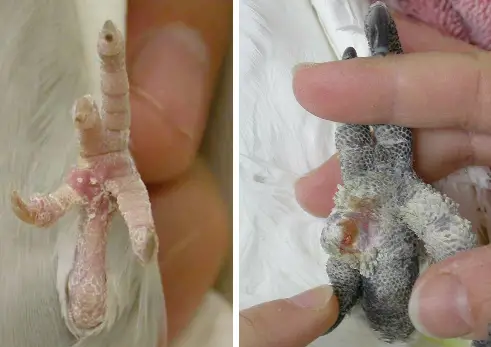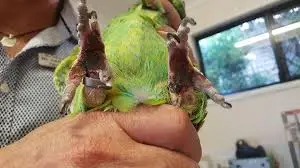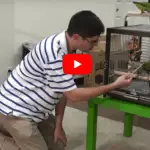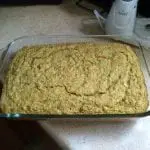Birds also suffer from different foot and leg conditions, which can be potentially dangerous, like such a tumor or nerve damage. While some of these conditions can be resolved with simple toenail clipping or perch change, some would need in-depth medical treatment because they can be caused by toxicosis, stroke, or nerve compression.
In this post, you’ll learn how to respond to the foot problems of your pet parrot so you can provide the appropriate intervention it needs.
Bumblefoot Is a Common Foot Problem in Parrots
It’s important to consult a veterinarian if your parrot has foot problems, like bumblefoot. This inflammatory condition involves swelling of the soles of the parrot’s feet. In some cases, parrots suffering from bumblefoot or any other foot problem can develop serious bacterial infections that possibly life-threatening.

Causes of Birds Foot Problems
As a responsible pet parrot owner, pay close attention to your pet’s skin changes and feet structure. Your parrot may need to endure chronic pain and eventually experience lameness.
1. Trauma or Injury
A foot problem may start as a simple blister, or it could be attributed to trauma or nerve compression, which is a relatively serious condition.
2. Small Cuts
The perch of your parrot can be a source of feet irritation, most especially if your pet has small cuts in the feet’s soles. It could be a viable entrance of microorganisms or germs, such as bacteria or fungus.
3. Overgrown Toenails
One of the most commonly overlooked problems in pet birds, like parrots, is overgrown toenails. Too-long toenails may cause limping, most especially if you observe the first joint of your parrot’s the nail is bent on one side of the toe is rising from the perch’s surface.
4. Poor Nutritional Status
The nutritional status of your bird may positively or negatively affect the health of your pet parrot, including the feet. Lack of Vitamin A is common among birds, which can also affect the skin’s condition. So, you have to make sure that your pet gets enough amount of Vitamin A to avoid scaly and rough skin, which can lead to infection, pain, and discomfort.
Signs of Foot Problems in Parrots
1. Constant Shifting
When your parrot has any condition that affects the soles of the feet or the legs or any injury, the discomfort usually shows in a constant shifting, which is from one foot to another.

2. Curling of the toes
3. Splayed legs
4. Shows Weakness
5. Shows signs of discomfort or pain
6. Swollen and warm feet
7. Paralysis
8. Chewing, stomping
What is Bumblefoot?
Bumblefoot is medically termed pododermatitis that usually occurs in raptors and psittacines, including cockatiels, budgerigars, and heavy-bodied birds like Hyacinth macaws and Amazons.
The sole of the feet of parrots with this foot condition vary. It may start as a mild thinning then reddening of the sole. Also, it may result in a severe chronic infection such as osteomyelitis, a type of bone infection. A life-threatening condition, like septicemia, may result and even cause death brought about by secondary infections. Bumblefoot may also affect just one digit. A lesion is usually found on the hock region’s underside.
What Causes Bumblefoot in Parrots
Environmental causes usually include parrot perches. Like other bird foot problems, having an improper size of perch may cause insufficient foot exercise. Also, sanded perches or too dirty or too rough perches may cause bumblefoot.
The major causes include foot sole punctures or digits among parrots include bite wounds or sharp talons inflicted by their prey. Also, environmental and nutritional factors may cause bumblefoot. Lack of biotin, calcium, vitamin A, vitamin D3, high-fat diet, or other nutritional deficiencies can result to bumblefoot.
Feces or spoiled food or feces caked to parrot perches can also become a source of infection in which bacteria can multiply. The common bacteria include staphylococcus, streptococcus, pseudomonas, Mycobacteria, and Candida. Even a minor foot abrasion may result in infection. Also, harsh cleaning solutions may cause initial irritation, so make sure that these agents are rinsed thoroughly when cleaning your parrot’s cage.
Other Conditions That Might Be Confused with Bumblefoot
- Fungal lesions
- Articular gout urate tophi
- Poxvirus lesions
- Parasites (filarial nematodes and knemidokoptes)
- Insect bites
- Small localized abscesses
- Callus formation because of old fractures, burns, trauma, frostbite, or benign tumors and papillomas
Symptoms of Bumblefoot in Parrots
- Grade One: Thinning of the foot’s plantar surface with some reddening.
- Grade Two: It involves thinning of the foot’s plantar surface that progressed up to the point of the subcutaneous tissue, like tendons seen through the skin.
- Grade Three: Ulcers form on the feet’ plantar surface with the formation of calluses around the lesions’ edges. Some mild lameness and pain are present.
- Grade Four: A necrotic plug will form in the ulcer’s central part, and lameness and pain are present.
- Grade Five: You’ll notice signs of edema, swelling, and cellulitis. Also, the area of necrosis is present, and the digits or foot can be filled with fluid or swollen with edema. Metatarsal pads and tendons can become infected. Also, severe lameness and pain are present.
- Grade Six: With this severity, digits are swollen. The foot’s plantar surface has necrotic flexor tendons that can rupture. Even with medical treatment, a fusion of joints and ankylosis, and non-functioning digits will be present.
- Grade Seven: Bone infection and osteomyelitis can progress to septicemia or systemic infection or even death.
How to Treat Parrot Feet Problems
- Use a Grooming Perch
If ever your parrot is resistant to toenail-clipping, you can use a grooming perch as a great solution. Your parrot can use this perch on his own to enable proper nail length. By providing different diameters, widths, and surfaces of perches, they will enable the parrot to shift and stand comfortably. If uneven or awkward, your parrot suffers from a painful arthritic condition. This condition may worsen over time. That’s why you have to keep perches sturdy and clean. Avoid sanding perch covers.
2. Provide Adequate Nutrition
Proper nutrition is very important for your parrot to avoid foot problems. Provide foods rich in Vitamin A for healthier skin, such as orange or red vegetables (sweet potatoes, carrots, red peppers, papaya, squash, mango) and dark green leafy veggies broccoli, spinach, and collards. Also, beta-carotene supplementation is very effective.
3. Warm Water Soaks
Scaly and painful feet can be alleviated with warm water soaks. A parrot with sores or scales on the feet may suffer from great discomfort, and warm soaks may soften the skin and loosen rough matter.
4. Bring Your Parrot to the Veterinarian
If you’re concerned about the physical changes observed in your parrot or you suspect that your pet is experiencing discomfort or pain, you should schedule an appointment with a veterinarian as soon as possible. The vet will prescribe a course of antibiotics to treat infection and inflammation, as well as pain medication.
Conclusion
The quality of life of your pet parrot is rooted in the comfort of its feet and legs. You’ll be able to observe any foot problem based on its posture, and how your parrot perches within the cage. Avoid sanding the perches of your parrot, and covering it with a rough material because parrots usually stand for prolonged periods. If you observe signs of foot problems, contact a veterinarian right away.



